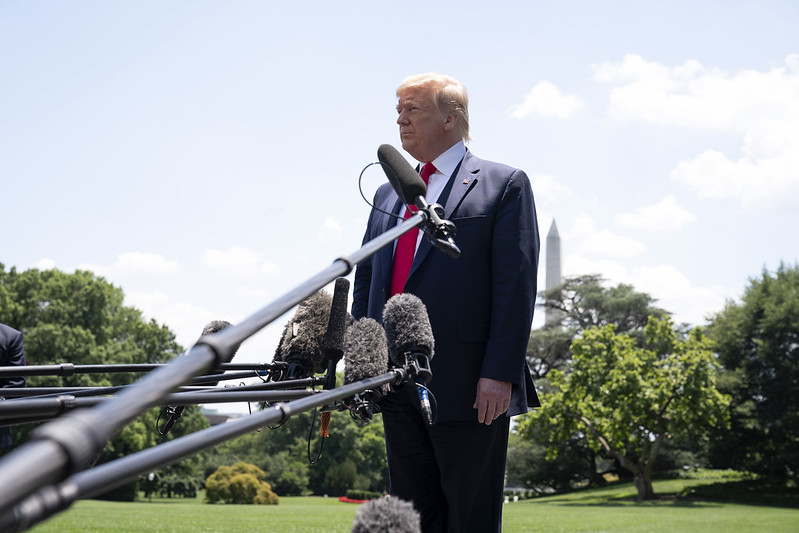President Donald Trump has floated the idea of eliminating income taxes for Americans making less than $200,000 per year. In a Truth Social post, Trump stated that the revenue from tariffs would allow him to pursue legislation where “people’s Income Taxes will be substantially reduced, maybe even completely eliminated.” Nobody likes paying income taxes, and giving that income back to a broad swath of Americans, including lower-income earners, could substantially help their finances and potentially increase their purchasing power. However, taxes are a bit like going to the dentist: It’s a pain and often downright uncomfortable, but they’re a necessity. Trump’s potential tax cut proposal, while still far from reality, could have unintended consequences. Here are two things investors should know.
It could worsen the country’s finances
While bigger and more complex, the U.S. government is essentially one large business. Every year, there are expenses, some of which are mandatory and some discretionary. The government also collects revenue, largely through various forms of taxes, most notably personal income tax. The government has let its finances get out of control. In 2024, the government operated at a $1.83 trillion fiscal deficit, meaning it spent that much more than the revenue it collected. This partly stems from the whopping $36 trillion plus of debt the country has accumulated, which requires large interest payments each year that cut into the budget.
The fiscal situation has gotten so out of control that there have been times of trouble in the bond market when yields have escalated to alarming levels during times when investors might have expected them to fall. This was likely due to bond investors requesting more yield for what they considered to be a riskier financial situation for the government. The U.S. is still successfully issuing trillions of debt, and the dollar is still the world’s reserve currency, but many experts say the situation is untenable in the long term.
Tax cuts can add to the difficulties because they reduce revenue for the government, which could exacerbate the deficit. “The math just doesn’t add up,” Erica York, vice president of federal tax policy at the Tax Foundation, said, according to CNN. “Not even close.” CNN also reported that income taxes bring in about $3 trillion of revenue for the government, while the U.S. also imports about $3 trillion of goods every year. That means tariffs would have to offset every lost dollar of income tax revenue. According to a Fitch report from April 23, the current tariff rate in the U.S. was only 22.8%, and that’s with extremely high levies on China that many, including Treasury Secretary Scott Bessent, have reportedly called unsustainable.
According to the Peter G. Peterson Foundation, which proclaims itself to be nonpartisan, the bottom 80% of American households, which are defined as three-person households making $176,700 or less, paid about 31% of all federal income taxes in 2019. That means tariffs would need to go higher from where they are, and most people expect tariffs to go down in trade agreements, considering they are already much higher than they’ve been at any time in history.
Official White House photo by Joyce N. Boghosian.
More tariffs could reduce demand
The impact of leaving Trump’s tariffs in place for the long term is also unclear. While tariffs certainly raise revenue, they could also stunt growth because when prices go up, they eat into people’s spending power unless wage growth offsets this. The Trump administration hopes that tariffs could make U.S. companies more competitive and bring back good-paying jobs, but unwinding years of globalization may not be so easy to do with one swift blow.
Although it’s early in Trump’s tariff saga, tariffs already seem to be hurting growth. U.S. gross domestic product (GDP) contracted 0.3% in the first quarter of the year, coming in below estimates of 0.4% growth. Imports, which detract from GDP, soared in the first quarter, as businesses may have been trying to get in front of the looming tariffs that Trump announced in early April. But Fwdbonds’ Chief Economist Chris Rupkey said, “… there is simply no way for policy advisors to sugarcoat this. Growth has simply vanished.”
Now, economists do expect a rebound in the second quarter of the year, which includes April, May, and June. The Federal Reserve Bank of Atlanta’s GDPNow service was projecting 1.1% real GDP growth (accounting for inflation) as of May 1, which is down from 2.4% in April. However, this very well could change in the coming weeks and months, depending on what happens with trade and tariffs as well as the labor market.
If real GDP were to contract again in the second quarter, the U.S. would find itself in a technical recession, which occurs when real GDP contracts for two consecutive quarters. Even missing estimates by a wide margin, though, would likely have a negative impact on growth this year because businesses and consumers are more likely to pull back if they see choppy waters on the horizon.

